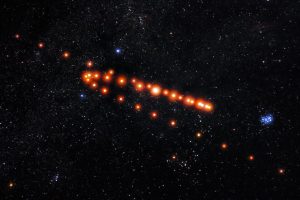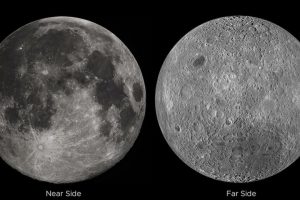
Some of the most famous bright stars in the sky – Aldebaran, Algol, Arrakis, Deneb, Fomalhaut, Rigel, Thuban, Vega, and Betelgeuse – have Arabic names. These names bespeak their link to the Arab and Muslim astronomers who observed and named them centuries ago. Some of the oldest names have their roots from the ancient Arabs before the rise of Islam. Later, many other Arabic names came about as translations of the Greek names. In Western astronomy today, the majority of accepted names for stars have Arabic roots. Only a few are of Greek origin. Specifically, there exist 210 stars with Arabic names, of which 52% are authentic Arabic originals, 39% are translated Ptolemaic originals, and 9% are conjecture or erroneous readings.[1] Other ancient star names were altered during the Middle Ages and Renaissance by European writers who incorrectly copied or translated the Arabic names. Many of the advancements in astronomical observations and instruments to aid in these endeavours were made by Muslim astronomers in the Islamic Golden Age, while Europe was still in the Dark Ages – and intellectual thought and innovation was stifled by the church. In 2016, the International Astronomical Union (IAU) designated official star names to streamline the different stellar naming systems. As a result, many bright stars were officially given their commonly recognised Arabic names.
| Star Name | Meaning |
| Aldebaran | ‘The Follower’ |
| Algol | ‘The Ghoul’ |
| Arrakis | ‘The Dancer’ |
| Deneb | ‘Tail’ |
| Fomalhaut | ‘The Fish’s Mouth’ |
| Rigel | ‘Foot’ |
| Thuban | ‘Snake’ |
| Vega | ‘Stooping Eagle’ |
| Betelgeuse | ‘The Hand of the Giant’ |
The Spread of Muslim Astronomy
Claudius Ptolemy, the 2nd-century Egyptian-Greek astronomer and mathematician, wrote the treatise Almagest, [2] detailing the motions of over a thousand stars and the orbits of the solar system planets. The Almagest had a long-lasting impact on Islamic and European science for more than a thousand years. It was translated into Arabic in the 8th and 9th centuries, and then translated into Latin in the 12th century.
Ptolemy came to four major conclusions in the Almagest:
- The celestial realm is spherical, and moves as a sphere.
- The Earth is a sphere and at the centre of the cosmos.
- The Earth has no appreciable size in relation to the distance of the fixed stars and must be treated as a mathematical point.
- The Earth does not move.
Al-Sufi, a 10th century Persian Muslim astronomer, wrote the Book of Constellations of the Fixed Stars (Kitab Suwar al-Kawakib al-Thabita) [3]. This work expanded the stellar catalogue of Ptolemy’s Almagest. Al-Sufi’s work corrected inaccurate observations in the Almagest and included those observations not recorded by Ptolemy. The majority of Arabic star names that we use today were recorded in Al-Sufi’s treatises. His work marked a paradigm shift for astronomy because it provided the positions, colours, and brightness of the stars visible with the naked eye based on observations, connecting for the first time in history the old Arabic names of stars with stars that were identified and observed. Al-Sufi was also the first astronomer to observe the Andromeda galaxy as well as the Large Magellanic Cloud (a satellite galaxy of the Milky Way). These observations were made with the naked eye since the telescope had not yet been invented at that time! This work was later helpful for Tycho Brahe’s accurate and comprehensive measurements of stars and the solar system planets.
At the request of Alfonso the Wise (King of Castille and Leon), Al-Sufi’s work was translated into Spanish as Libros de las Estrellas de la Ochava Esfera, which he combined with his Libros del Saber de Astronomía (Books of Astronomical Knowledge), [4] to include updated positions of the sun, the moon and the planets. Al-Sufi’s works also influenced other Muslim astronomers, including Ulugh Beg of Samarkand in the 15th century, who founded the largest observatory in the Islamic world. At this observatory, astronomers worked together to collate the Zij-i Sultani star catalogue. This catalogue listed the names and positions for approximately a thousand stars. The names listed in stellar catalogues, instruments and maps of the celestial sphere can be traced back to Al-Sufi or Ulugh Beg. Further, Ibn al-Haytham developed optics, the science of how we perceive light – which led to the development of the camera obscura and the telescope. Muslim women also contributed to advancements in the field. For example, the design of the astrolabe, a tool that was used to locate celestial objects in the sky, tell time during the night, and identify the time of the sunrise and sunset, was refined by the Syrian astrolabe maker Mariam al-Astrulabi.
How did Arabic Star Names Persist?
The Arabic star names were first brought to Spain in the Middle Ages between the 10th-13th centuries. Christian astronomers directly incorporated the names into their European astronomical works, including Aldebaran, Algol, Alhabor Rigel and Vega. The Arabic names of these bright stars and others were then used for centuries for celestial navigation by sailors, mariners and explorers. The Arabic names of the brightest and most well-known stars demonstrate the legacy of the Islamic golden age of scientific thought in astronomy – a legacy that persists today. Scientists from Islamic Spain, North Africa, the Middle East, and India during the 9th-15th centuries recorded their work in the Arabic language and laid the foundations in mathematics and astronomy, as well as in other fields. Their scientific contributions then provided the groundwork for Europe’s intellectual Renaissance, of which astronomy was at the forefront.
The Continued Influence of Muslim Astronomy on Europe
Johann Bayer introduced twenty-two additional Arabic names to Europe in the 16th and 17th centuries. Scientists and writers soon began using these names. Bayer wrote the stellar atlas Uranometria [5] in 1603 AD which contained 51 star maps. To assemble this atlas, he used precise stellar positions from Tycho Brahe and introduced a new naming convention for stars. His naming convention used Greek letters to denote brighter stars (Alpha Centauri, for example) and used the popular/common names for the more wellknown stars. He drew these names from the Latin translations of the Almagest and Spanish translations of Al-Sufi’s work. Al-Sufi’s work was also translated into Latin in 1665 AD by Thomas Hyde, called Tabulae longitudinis et latitudinis stellarum fixarum ex observatione Ulugh Beighi [6] which was later reprinted in 1767 AD and 1843 AD. Additionally, Jakob von Christmann translated al-Farghani’s work into Latin.
A Persisting Legacy
The influx of the knowledge and legacy of Muslim astronomers continued to flow into Europe well into the 20th century. Giuseppe Piazzi facilitated the building of Palermo Observatory. He assembled a catalogue of over 6,000 stars and named the stars based on modifications from the Hyde catalogue – a translation of Al-Sufi’s work. This catalogue became a benchmark for stellar astronomy. In 1809, Aja’ib al-Makhluqat (The Wonders of Creation) [7] by Zakariya al-Qazwini was translated by Ludwig Ideler, where he also included commentary on the meaning and origin of these names. Star-Names and Their Meanings by Richard Hinckley Allen was published in 1899 and further popularised star names of Arabic origin in the US – even bringing these names to Webster’s Dictionary.
About the Author: Dr Munazza Alam is an astronomer, National Geographic Young Explorer, and postdoctoral researcher at the Carnegie Earth & Planets Laboratory in Washington, DC. She also serves as a Deputy Editor for the Science Section in The Review of Religions.
ENDNOTES
- https://web.archive.org/web/20080623093205/
https://astro.isi.edu/reference/starnames.txt - https://www.google.com/books/edition/Ptolemy_s_Almagest/hOfaDwAAQBAJ?hl=en&gbpv=1&printsec=frontcover
- https://www.loc.gov/resource/amedscd.2008401028/?st=gallery
- https://www.loc.gov/item/2021668130/
- https://www.researchgate.net/publication/262579483_The_Milky_Way_in_Johann_Bayer%27s_Uranometria_1603
- https://inlibris.com/item/bn52374/
- https://collections.library.yale.edu/catalog/2042070




Add Comment